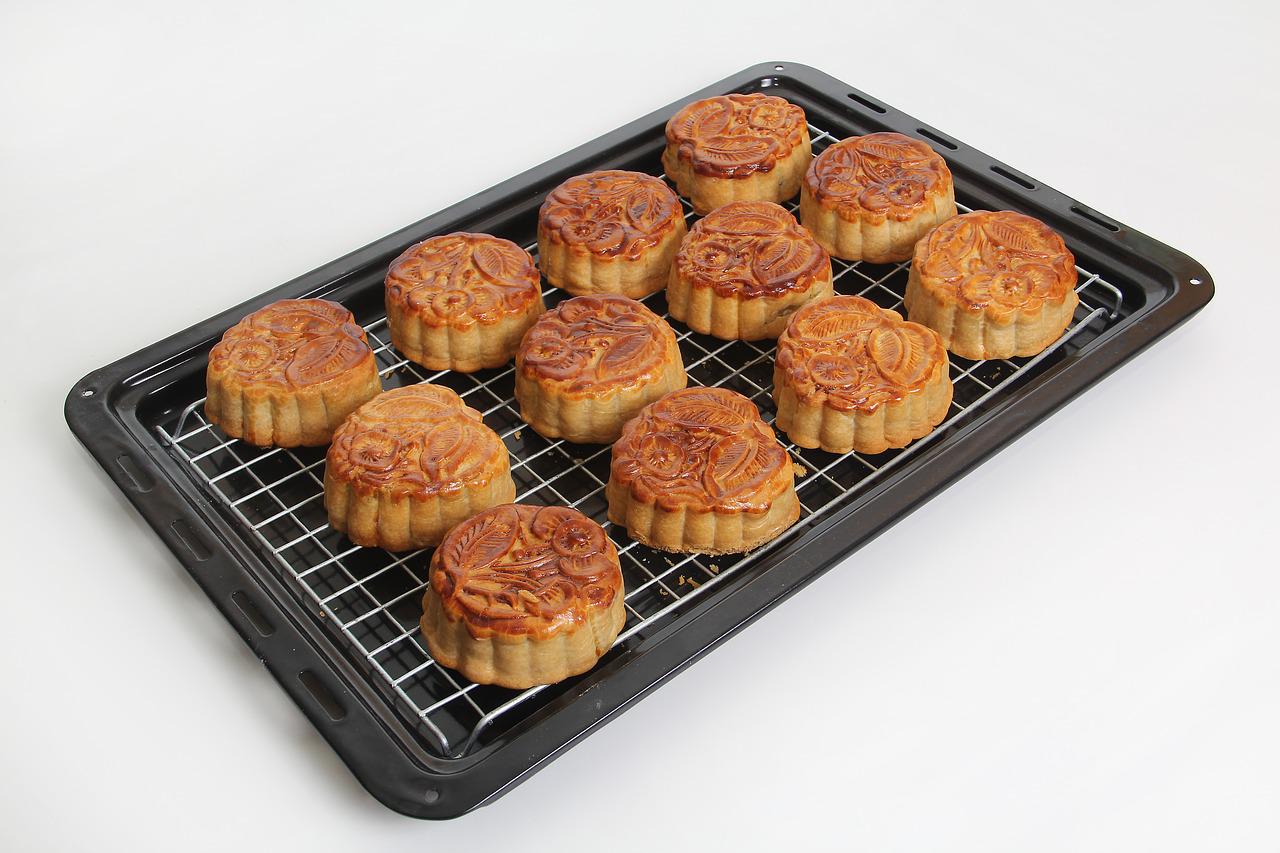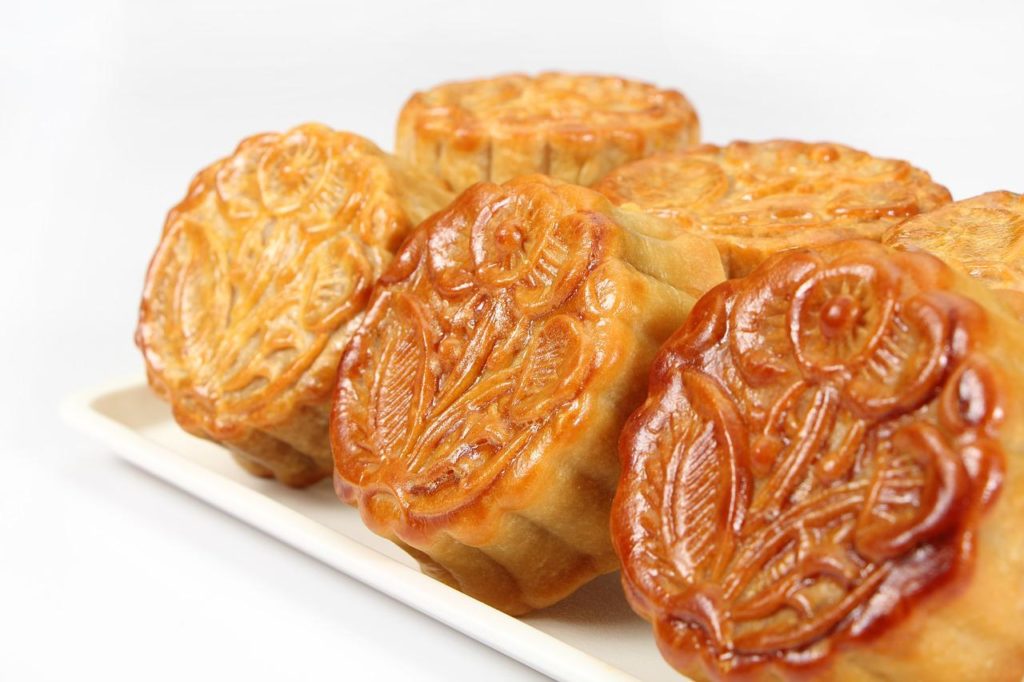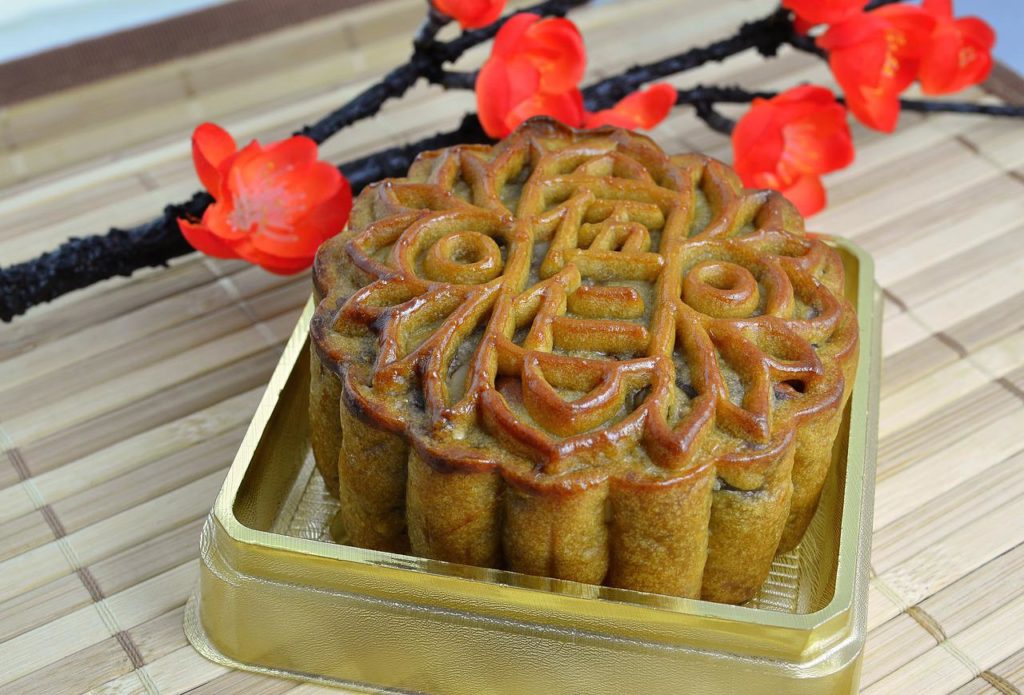Mooncakes are the most well-known Mid-Autumn Festival delicacy. The Mid-Autumn Festival is China’s second most important holiday, after Chinese New Year, but it is also observed in many other Asian countries. The festival is celebrated with family gatherings, feasts, and an abundance of lights, lanterns, and candles on the 15th day of the 8th month of the Chinese lunar calendar. The name mooncake comes from making it to commemorate the fullest and brightest moon of the year.
Mooncakes are typically made with a sweet baked dough on the outside and red bean or lotus seed paste and salted duck yolks on the inside to represent the full moon. This version uses only red bean paste, but you can get creative and use any nut or seed paste.
What is Mooncake?
Mooncakes are traditionally eaten during the Chinese and Vietnamese Mid-Autumn Festivals when families gather to express gratitude for the harvest and pray for long life and good fortune. One of the highlights of this festival (some even call it the Mooncake Festival!) is making and sharing mooncakes. In Chinese culture, a round shape represents completeness and reunion, and sharing round pastries with relatives represents family unity. The pastries are made with a tender dough and a sweet filling, usually lotus seed paste or red bean paste.
The intricate design on the top of each mooncake is created by pressing the pastry into a mold; traditional molds are shaped like wooden paddles, while modern presses are spring-loaded and made of plastic. Bakers stamp their mooncakes with their designs, including flowers, vines, and moons. Every family has its version of the pastry, which is based on passed-down recipes or where the cakes are purchased. Most have a sweet filling wrapped around a salted duck egg yolk.
Still, our version omits the yolk and instead focuses on white lotus paste, which is made by boiling and pureeing dried lotus seeds before cooking them with caramelized sugar. We bake the mooncakes for 10 minutes before brushing them with egg wash to set the beautiful stamped design (the key to their glossy finish).
What does Mooncake Taste Like?
The flavor and texture of mooncakes are determined by the ingredients used. Mooncakes come in various shapes and sizes, with various fillings and methods for making the outer crust. Mooncakes are traditionally made with a sweet, flaky pastry similar to pie crust. They’re usually filled with sweet fillings like red bean paste, which has a creamy texture and a sweet, earthy flavor.
How to Make Mooncake?
Here is the best recipe to make mooncake:
Ingredients
Lotus Paste
- 1 cup dried lotus seeds
- 3/4 cup plus two tablespoons sugar
- One tablespoon plus 1/3 cup vegetable shortening
Mooncake Dough
- 1/4 cup golden syrup
- 1/2 teaspoon alkaline water (also called kansui)
- Two tablespoons of vegetable oil
- 2/3 cup cake flour
- 1/3 cup all-purpose flour, plus more for dusting
- One large egg, lightly beaten
Directions
Here are the steps to follow:
- Place the dried lotus seeds in a medium bowl and cover with plenty of room temperature water. Let the seeds soak and rehydrate for at least 6 hours, preferably overnight.
- Remove and discard the green sprout in the center of the lotus seeds by rinsing them under cold water and splitting them in half (they are very bitter). Fill a large pot halfway with water and place the seeds in it. Bring to a boil over medium-high heat, then reduce to medium-low and continue to cook for 1 hour, or until the seeds are tender enough to mash with a fork. Drain well, then transfer the seeds to a food processor with 3/4 cup sugar and puree until very smooth while still warm. (If necessary, add 1 to 2 tablespoons of water to achieve a very smooth texture.) Into a medium bowl, strain through a fine-mesh sieve.
- In a medium nonstick skillet, melt one tablespoon vegetable shortening and the remaining two tablespoons sugar over medium-high heat, then cook until caramelized and deep golden, about 5 minutes. Add the lotus puree and cook, constantly stirring, for 6 to 8 minutes, or until most of the moisture has evaporated and the puree resembles thick mashed potatoes in texture. Continue to cook, constantly stirring, until the remaining 1/3 cup vegetable shortening has been fully incorporated. The paste is very thick, glossy, and pulls away from the sides of the pan for about 6 minutes more. Allow cooling completely in a medium mixing bowl.
- Meanwhile, whisk together the golden syrup, alkaline water, and vegetable oil in a large mixing bowl until well combined. Stir in the cake and all-purpose flours until a shaggy dough forms with a wooden spoon. Gently knead the dough until it is completely smooth, wrap it in plastic wrap, and set it aside to rest for 45 minutes.
- Preheat the oven to 350 degrees Fahrenheit. Using parchment paper, line a baking sheet.
- Roll the lotus paste into golf-ball-size balls by dividing it into 12 equal pieces (about 2 1/2 tablespoons). Refrigerate for 20 to 30 minutes after placing on a plate. The easier it is to shape the mooncakes, the colder the balls are.
- One tablespoon of mooncake dough, rolled into a ball, placed between 2 parchment paper sheets lightly dusted with flour. Flatten the dough with a rolling pin to about 1/8 inch thick and 3 1/2 to 4 inches wide. Place one of the lotus paste balls in the dough’s center and shape it around it, pinching the edges to seal it. To smooth the ball’s exterior, roll it in your hands.
- Place the assembled ball in a 2-inch wide plastic miniature mooncake press mold and set it upright on your work surface. Plunge the plunger until you feel resistance, then lift the mooncake mold off the table and carefully press the mooncake out with the plunger. Transfer to the prepared baking sheet and refrigerate while you finish the rest of the mooncakes.
- Bake the mooncakes for 10 to 12 minutes, or until the tops are no longer shiny and the dough has just set. Allow 10 minutes for cooling. In a small bowl, whisk together the egg and a splash of water, then brush over the tops and sides of each mooncake. Return to the oven and bake for another 10 to 15 minutes, or until golden brown. Allow cooling for 10 minutes on the baking sheet before transferring it to a cooling rack to cool completely. Enjoy them right away, or keep them in an airtight container for up to 2 days (they’ll get shinier as time goes on).
How Long do Mooncakes Last?
Normal mooncakes (baked mooncakes) can be stored for up to 60 days in a cool place between 5 and 25°C (41 and 77°F) and not exposed to heat. Mooncakes can be stored for a minimum of 20 days and a maximum of 60 days, depending on the ingredients and preparation method. If you’re buying mooncakes from the supermarket, check the expiration date first.
Mooncakes made by hand can only be kept for 7 to 10 days at temperatures below 25°C (77°F). If the temperature rises above 30°C (86°F), the days should be cut to seven days.
Snow skin mooncakes should be stored in the refrigerator at temperatures between 2 and 5 degrees Celsius (35.6 and 41 degrees Fahrenheit) for a few weeks. Otherwise, they’ll go bad in about 2 hours.
Varieties of Moon Cakes
Moon cakes come in a dizzying array of flavors and are available at least a month before the festival. Aside from the traditional mooncakes, you might come across some mooncakes that have been infused with western flavors. Here are the varieties of mon cakes:
- Traditional Moon cakes
- Beijing-Style Moon cakes
- Cantonese-Style Moon cakes
- Yunnan-Style Moon cakes
- Suzhou-Style Moon cakes
- Snow-skin Moon cakes
- Fruit and Vegetable Moon cakes
- Ice cream Moon cakes
Tips for Eating Mooncakes
Mooncakes are traditionally made with a lot of oil and sugar, considered unhealthy. If you eat too many moon cakes at once, your digestive system will be strained, so a cup of oolong or red tea will come in handy. Nowadays, mooncake manufacturers make healthier mooncakes with less oil and sugar, allowing consumers to buy more with confidence.
Conclusion
Moon cake eating is a long-standing tradition. The moon cake is a wheat-based food. The filling is red-bean, lotus paste, salty egg yolk, preserved fruit, and chocolate, and the dough is flour, oil, and sugar. Moon cakes filled with black truffle, caviar, and foie gras are available in some metropolitan areas, such as Shanghai and Hong Kong.
In addition, the relief patterns on the moon cakes are beautiful. The most famous mooncake is the Cantonese-style mooncake, distinguished by its golden and glossy crust, which is thin and soft with a delicate pattern. Lotus paste, a sweet paste made from lotus seeds, and salted duck egg yolks are the most common fillings for these.


